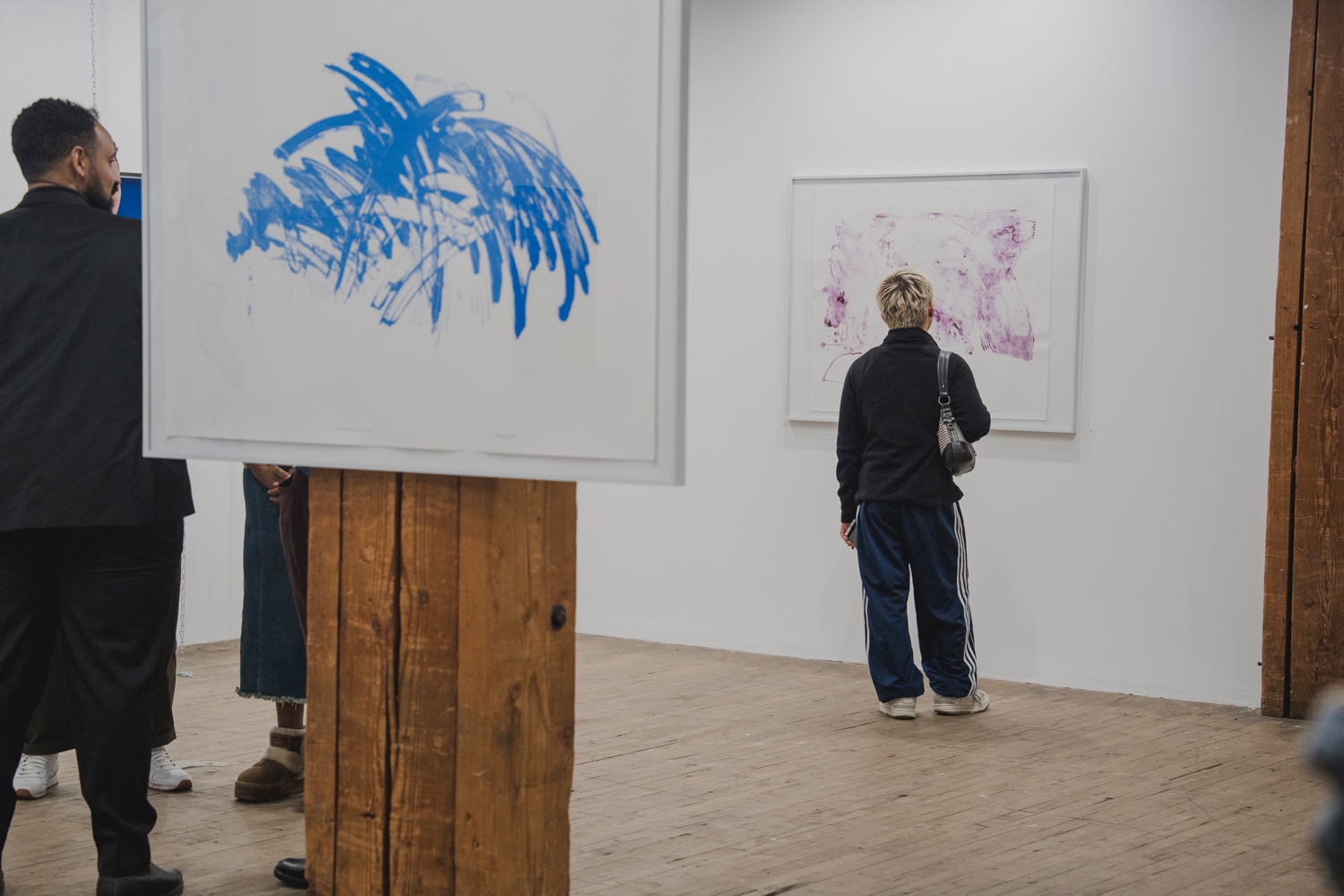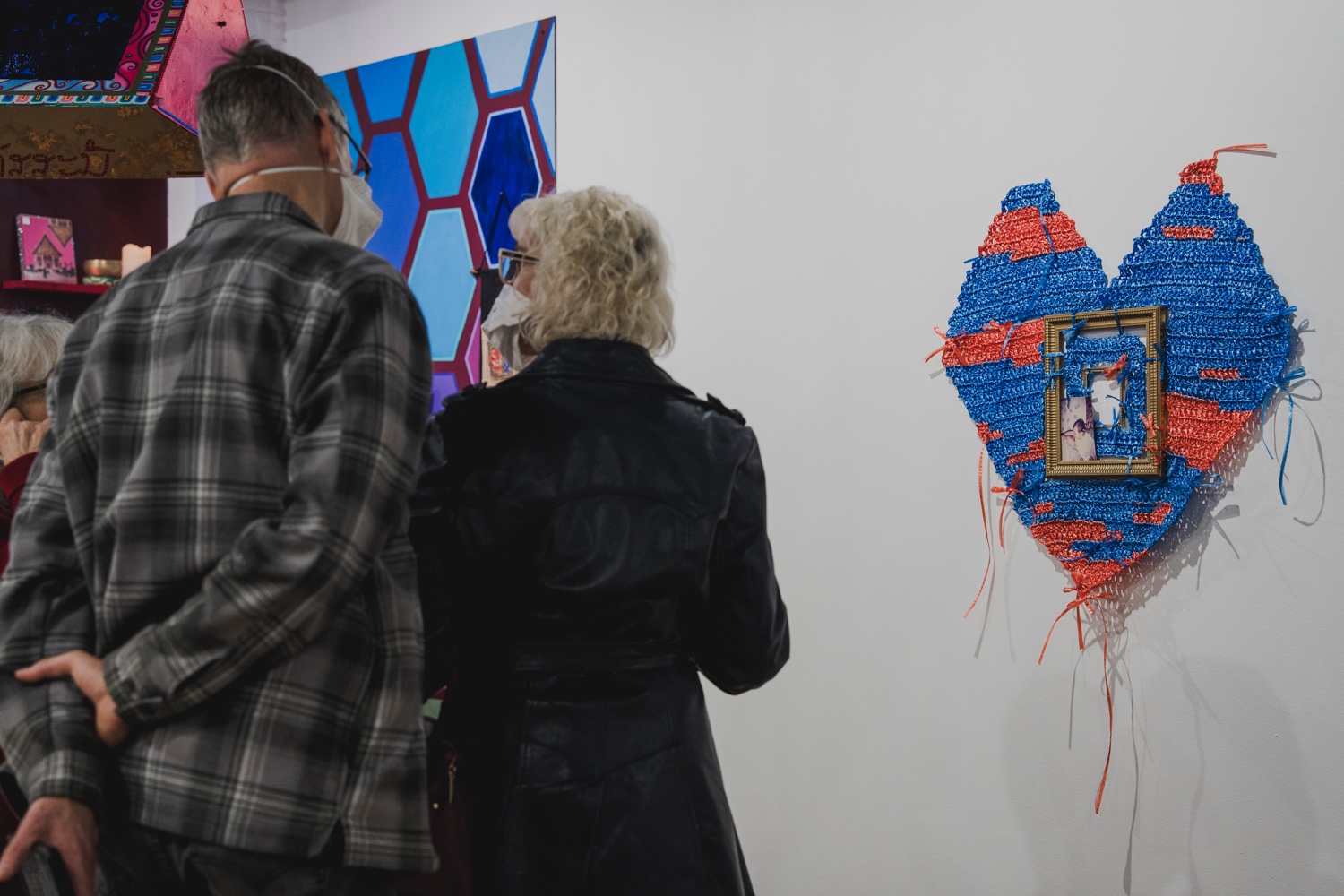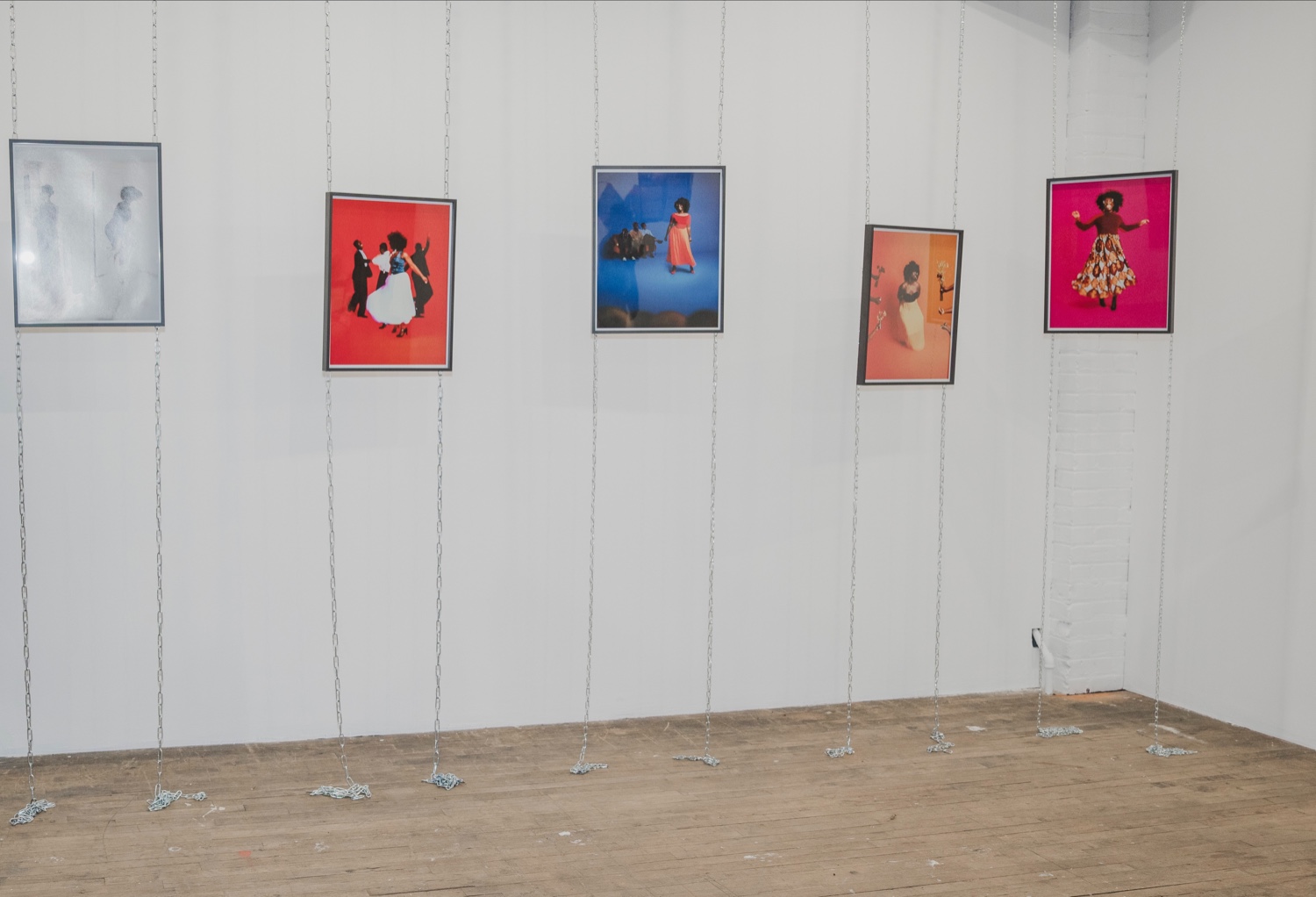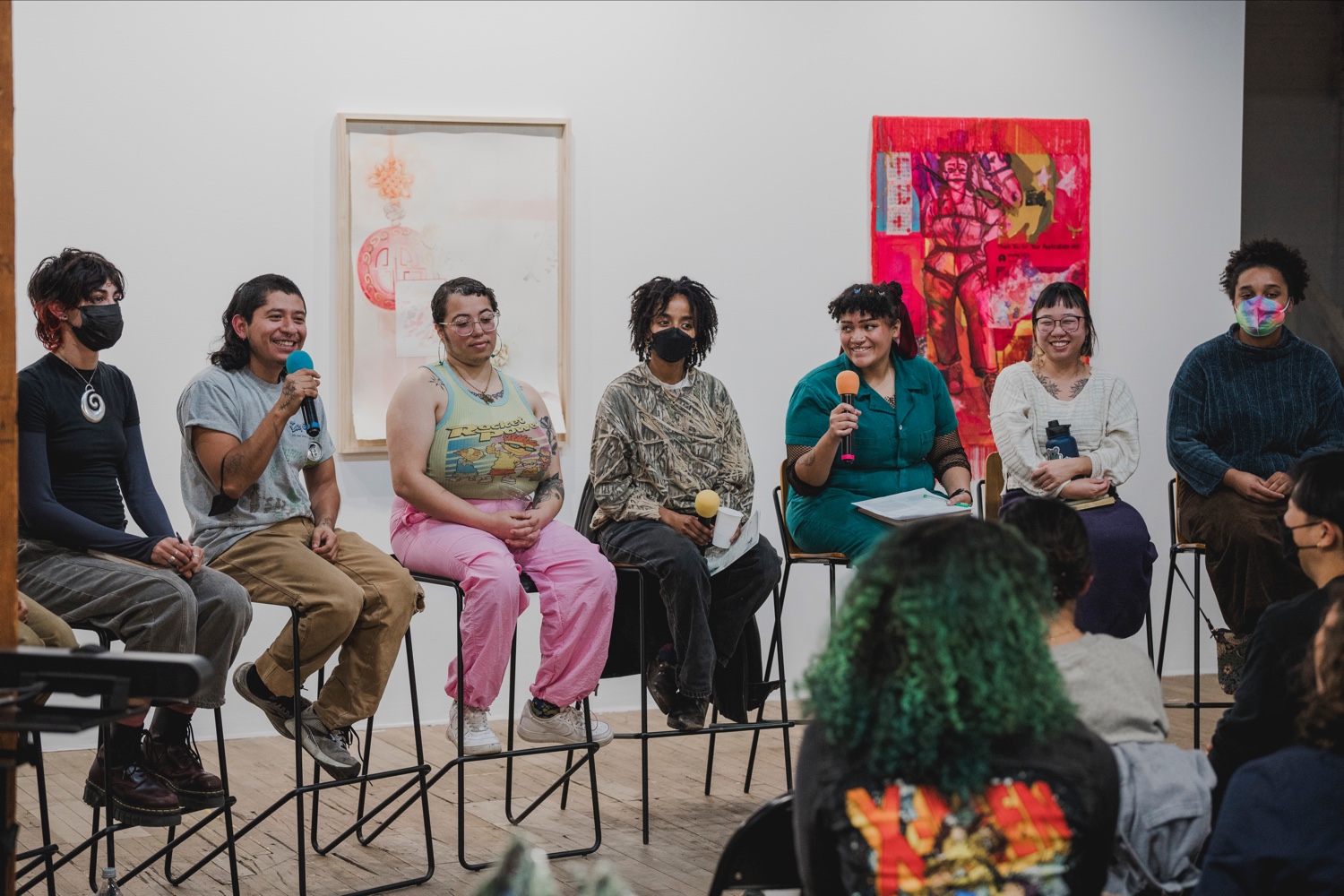
In Regard to the Fringe: Composition as a Multifaceted Thing
Published November 20th, 2024 by Cory Eull
PF Studios celebrates its 5th year while curator Jonathan Herrera Soto positions us “within the active composition of our lives” in a group show at Public Functionary
Banner image: León Valencia Currie, push/ through (detail), 2024. Ink on paper, 35mm film, bullets, prescription medication bottles, milk crate. All photos by Drew Arrieta, courtesy of Public Functionary.
“Prioritizing the detritus” — the things that feel unimportant, and the sketches that didn’t lead to anything — expands what could be potential material. A group exhibition on view at Public Functionary, Your Hands Were Making Artifacts in the Corner of my Mind, centers the work of artists who "turn toward their practices as fertile soil," as the exhibition text says. While committing to daily practice and acknowledging the intense pressure to complete a work, “These artists move from particular to particular, changing one’s mind, and keeping what remains. Akin to the act of drawing, they approach their work not founded in logic but made up of contingencies, paradoxes, stray parts, and overflow.”
For Public Functionary’s five year anniversary of the PF Studios program, printmaker & mixed media artist Jonathan Herrera Soto was invited to curate their annual group show. In addition to setting the exhibition space, Herrera Soto was a quasi curator-in-residence, visiting from New Haven, Connecticut multiple times this year to engage intensely with the 22 artists preparing for the show. Herrera Soto probed them to look beyond the work. One of the themes in his own practice that came through in his methodical curating style was the integrating of porousness. In seeking “porous edges,” the handwritten notes, the strings, and b-sides that are usually left in the periphery of the studio space and cast aside so as not to contaminate the work at hand instead become indispensable. Consequently, the artist’s self begins to dapple the work. Herrera Soto’s concerns prompted material exploration, causing the artists to consider texture, habit, and their own lived-in material. Bridging the gaps between the art and life outside of the art practice, there was an honoring of personhood in the exhibit, with the site-specific bits folded in.

 Top: Whitney Terrill, Abstracted Emotions #1 & #2, 2024. Printmaking. Bottom: Hawwa Youngmark, In God’s Hands, 2024. Varied textiles, embroidery floss, posca pens, alcohol markers. Drew Arrieta/Public Functionary.
Top: Whitney Terrill, Abstracted Emotions #1 & #2, 2024. Printmaking. Bottom: Hawwa Youngmark, In God’s Hands, 2024. Varied textiles, embroidery floss, posca pens, alcohol markers. Drew Arrieta/Public Functionary.
Herrera Soto had the artists read Amy Sillman’s “Further Notes on Shape,” and encouraged them to see what exists outside of what they’re making and choose to include it. Through embracing permeability, they began to “include the negative,” as participating artist Jelani Ellis described it. Including the negative means viewing composition as a multifaceted thing, and asking if the coherence of one finally put-together piece is truly important, or if a work’s contents can spill beyond its predicted container. Of course there is a precarity there, because too much porousness will make things fall apart. Therefore each artist took a gamble at testing boundaries and ultimately at striking balance.
In Genie Hien Tran’s work, Here, Together, there is specifically a glossy dollar store ribbon and assemblage of knots constructing the shape of a heart. The particularity of the material and its attunement to something sentimental hovers around a photograph of Hien Tran as a kid. The photo is tucked into the corner of a frame which is woven into the center of the heart. This “tuck” was a gesture Herrera Soto and Hien Tran found significant — that tender slipping of a photo in the crotch of a picture frame, another precarious thing that is both site-specific and potentially cross-cultural, like clutching the shiny ribbon of a balloon in one's hand.
 Genie Hien Tran, Here, Together, 2024. Plastic twine, frames, and polaroid photo. Drew Arrieta/Public Functionary.
Genie Hien Tran, Here, Together, 2024. Plastic twine, frames, and polaroid photo. Drew Arrieta/Public Functionary.
“I think this is where cultural specificity meets the material and the conceptual," said the curator. "Something I really tried to talk to the residents about was material strategies and display strategies.” Wanting to avoid using fishing line for installation purposes, Herrera Soto pushed the artists to find twine-like materials that further conveyed their pieces. They began to not only think about the porous edges in their work but ask, “How does the work function? Stripping it of its image and its meaning making, how does hanging something high, hanging something low, and having it be part of the space contribute to the compost of its meaning?” Orientation was a concern in the space as well. Instead of the gallery feeling like a conveyor belt, with visitors walking from start to finish, there are pieces displayed in less predictable places, such as Whitney Terrill’s Abstracted Emotions #1 and Hawwa Youngmark’s quilted comic In God’s Hands, respectively creating additional walls and prompting more circular, in-the-round movement through the gallery.

 Top: Godfree Manley-Spain, Ms. Bessie’s Big One, 2024. Digital photographs. Bottom: Margaret Vergara, sing it again, though, 2024. Acrylic, linocut wheat-pasted on plywood, ceramics. Drew Arrieta/Public Functionary.
Top: Godfree Manley-Spain, Ms. Bessie’s Big One, 2024. Digital photographs. Bottom: Margaret Vergara, sing it again, though, 2024. Acrylic, linocut wheat-pasted on plywood, ceramics. Drew Arrieta/Public Functionary.
In Arnée Martin’s piece You Can’t Go Home Again, Martin worked a laborious knitting technique on mesh to create an image, the source being a family photo that would remain unrevealed in a layer beneath. They used a computer software to map out by number what colored thread would go where. Challenging this idea that what galleries wanted was a large, complete, labor-intensive work, Herrera Soto encouraged Martin to make an additional research piece for the gallery space and display the two small pieces on opposite sides of a column. The research piece showed the numbers printed on the mesh before any thread was brought in, and the view to the family photo was still opaque but discernible this time. This choice was aimed “to point towards the impossible predicament of being a studio artist," according to the curator. "There’s so many beautiful things that happen upstairs in the studios, but unfortunately we don’t have access to that, so how do you embed that truth in the space?” Often in the final stage of exhibition we don’t see the iterations a piece embodied before that final one, and there is loss there for the viewer.
In Jelani Ellis’ work (Untitled), I’m reminded of mood boards and early teen years spent ogling over neatly curated Pinterest boards. This is another piece that plays across one of the columns permanently situated in the gallery, and it is a study of composition, as elements of the piece sprawl from its epicenter, a work that is cohesive yet given islands to swim between. The peripheral seeped through the edges of Ellis’ piece — a mood board in itself, stray parts building the real thing, the chaff reclaimed to help build value, scale, and equilibrium.
Each piece in this show is expansive and spreading, like moss on a forest floor, or roots mingling, gathering nutrients from soil. Where does one piece end and another begin? It’s obvious Herrera Soto challenged and brought about something new in each artist. “What is my purpose as a teacher?” Herrera Soto inquires. “To construct conditions in which we learn from our work and our practice.” By helping artists peer into their processes instead of their finished work, Herrera Soto reminds them how to become unstuck by welcoming the fallible yet fecund watering hole of lived material back in to creative practice. ◼︎
 Left to right: León Valencia Currie, Jonathan Herrera Soto, Hawwa Youngmark, Nafyar, Grover Hogan, Elyse Lodermeier, and Jelani Ellis at the panel discussion earlier in November. Drew Arrieta/Public Functionary.
Left to right: León Valencia Currie, Jonathan Herrera Soto, Hawwa Youngmark, Nafyar, Grover Hogan, Elyse Lodermeier, and Jelani Ellis at the panel discussion earlier in November. Drew Arrieta/Public Functionary.
Your Hands Were Making Artifacts in the Corner of my Mind is on view at Public Functionary through November 30. Gallery hours are Thursday – Saturdays, 12 – 6pm, and the gallery will be closed Thursday, November 28. Follow the gallery on Instagram @pfunctionary.
You can see more of Jonathan Herrera Soto's work on his website and on Instagram @produce.work.
PF Studios is also celebrating their fifth anniversary with a book release, available for purchase through their website.
We can't do it without you.
Help keep independent arts journalism alive in the Twin Cities.